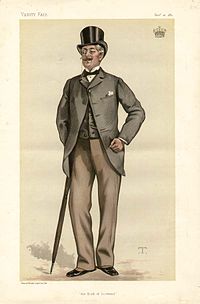Robert St Clair-Erskine, 4th Earl of Rosslyn
|
The Right Honourable The Earl of Rosslyn |
|
|---|---|

"The Kirk of Scotland". The Earl of Rosslyn as caricatured by Théobald Chartran in Vanity Fair, November 1881.
|
|
| Captain of the Gentlemen-at-Arms | |
|
In office 24 November 1886 – 11 August 1890 |
|
| Monarch | Victoria |
| Prime Minister | The Marquess of Salisbury |
| Preceded by | The Viscount Barrington |
| Succeeded by | The Earl of Yarborough |
| Personal details | |
| Born | 2 March 1833 |
| Died | 6 September 1890 (aged 57) |
| Nationality | British |
| Political party | Conservative |
| Spouse(s) | Blanche Adeliza FitzRoy (1839–1933) |
Robert Francis St Clair-Erskine, 4th Earl of Rosslyn (2 March 1833 – 6 September 1890), styled Lord Loughborough until 1866, was a Scottish Conservative politician. He served as Captain of the Gentlemen-at-Arms under Lord Salisbury between 1886 and 1890.
Rosslyn was the son of James St Clair-Erskine, 3rd Earl of Rosslyn, and Frances (née Wemyss).
Lord Rosslyn succeeded his father in the earldom in 1866. He served under Lord Salisbury as Captain of the Honourable Corps of Gentlemen-at-Arms from 1886 until shortly before his death in September 1890.
Robert joined Lodge Oswald of Dunnikier together with James Townsend Oswald on 8 April 1867.
In Addition to being Grand Master of the Grand Lodge of Scotland between 1870 and 1873, Lord Rosslyn also served as Grand Master of the Order of the Temple from 1884 until his death in 1890.
Lord Rosslyn married Blanche Adeliza, great granddaughter of Augustus FitzRoy, 3rd Duke of Grafton and widow of Colonel the Honourable Charles Henry Maynard, on 8 November 1866. They had five children:
Lord Rosslyn died in Dysart, Fife on 6 September 1890, aged 57. He was buried on 11 September, just west of Rosslyn Chapel, which traditionally has very strong masonic links. The monument is ornately carved in two different sandstones and is quite stunning. His wife Blanche was later buried with him.
The Countess of Rosslyn survived her husband by over 40 years and died at York Terrace, Regent's Park, London, in December 1933. She was described in her obituary in the New York Times as "one of the last survivors of the great Victorian hostesses". She knew personally many of the most famous people of the Victorian era, including Benjamin Disraeli and William Gladstone.
...
Wikipedia
